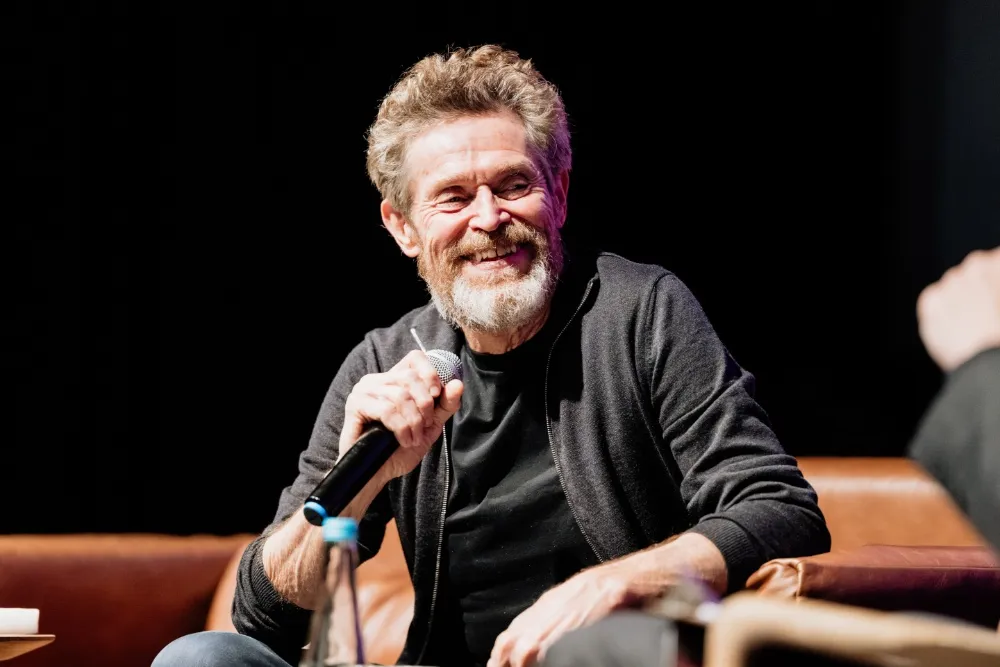American actor Willem Dafoe sat down for a packed masterclass at the Sarajevo Film Festival prior to receiving the Honorary Heart of Sarajevo award for his contribution to cinema. It’s been 25 years since he attended the festival as star of Steve Buscemi’s 2000 neo-noir Animal Factory. “It was just after the war, and it was a different Sarajevo than you see now,” he recalled.
Now aged 70, his celebrated career spans roles in more a hundred features, after Kathryn Bigelow saw him in a theatre play and cast him in his first credited role, the outlaw biker drama The Loveless (1981). Across the few performances he had time to touch on, Dafoe gave insight into his “non-transactional” approach to his craft.
“Acting for me is about doing things, and when you do things, you use your body. It’s not about conveying things, it’s about having an experience. Your body is a beautiful instrument. There are no deals being made, you’re giving yourself to nature, and nature is exposing itself. One of the things I love about acting is you’re not keeping score. You’re trying to be flexible, and get rid of all your preferences that are based on a conditioning that can close you off to feeling, passion, and wonder. As a director you have to lead people towards something, and kind of know what you’re doing, and that’s not my personality. The best things are found in not knowing,” he said.
Dafoe, famed for daring plunges into extreme roles, has worked with many directors with reputations for unconventional methods. David Lynch (who had him wear teeth-coveering dentures as the sleazy, unhinged Bobby Peru in Wild At Heart, 1990) would “sometimes say very abstract things, like, when you start this, you’re kind of like green, and then you become brown.” Robert Eggers (Dafoe was buried alive in his 2019 The Lighthouse) is a “freak for research” but “avoids showing off” his deep-dives into period detail, and “seduces you into being in that world.” Frequent collaborator Abel Ferrara is “very personal and it’s very fluid, he loves to be open to the things that happen. It’s no secret he was in bad shape, but he cleaned up.” Whereas Paul Schrader is all about the writing, and “expects you to know your job” (Dafoe felt so close to his craving New Yorker character in 1992’s Light Sleeper he could have been him “if his life was slightly different.”) He regrets never having worked with Stanley Kubrick. “I hear nightmare stories, but that doesn’t deter me.”
Collaborating with difficult or unusual personalities on set has never fazed Dafoe. “My ideal when you work with people is you kind of let them do what they do, and make room for them. If it’s something you don’t like just don’t engage with them; they’ll punch themselves out or go to a logical place for themselves and then you become available when the man is ready.”
Looking back on his beginnings, Dafoe reflected on the huge impact moving to New York City from his hometown in Wisconsin in 1976 had on his sensibility. There, he co-founded experimental theatre company The Wooster Group. “The city was in a very bad place, crime was really high. Being a Midwest, middle-class kid, moving to New York really radicalised me politically and my idea of what I was attracted to. And at that time there were a lot of people who were not trained to make art, theater or dance. There was a kind of amateur love, and the interesting part was it was never career-minded. It was circling the energy of youth, and nobody was thinking about tomorrow. This theatre company was very much that, we would work on things in the day and sometimes perform them at night. It taught me to not wait. It’s all about making something and reacting off what’s being made, not being paralysed by thinking. It was beautiful training.”
Martin Scorsese’s 1988 The Last Temptation of Christ, envisaged as an “elemental, primitive” take on the “human part of Jesus” was shot on a relatively low budget in Morocco. It was very demanding on Dafoe, but he cherishes it as one of his most formative and valuable roles, despite the swirl of controversy from the religious right that limited its release, and surprised him. “It was shot in an age of super-violent movies and porn. This is a movie that was going to address itself to the nature of faith. Even if you get it wrong, I think it was a sincere attempt,” he said. The primary challenge was to free himself from pre-existing images or expectations. “You’re not the Jesus Christ, you’re a Jesus Christ.” And, there was the astonishing crucifixion scene. “I’ve never seen a bluer sky, when you’re up there. Put anyone up on the cross, and you’ll have an experience,” he said.
“I’m always looking for these moments where you can be transformed, even if it’s for a moment,” Dafoe said on a career’s choice of roles. “Anything that builds you up to a new way of seeing is liberation. You see the interconnection of things, and it teaches you how to live. If you’re doing that, and you’re doing it in a sincere, transparent way, the audience is also experiencing that somehow. That’s the greatest power of films. They can take us to a place you can’t imagine, and it’s a place of wonder like when you first fall in love. Everything opens up and blossoms. You are not dragged down by the daily grind.”




